Hummingbird Gardens
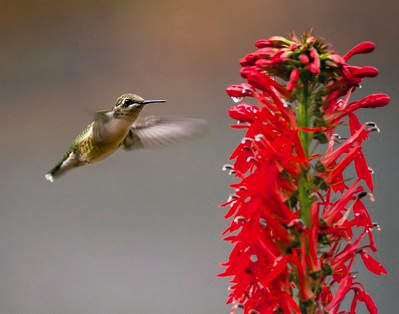
Hummingbirds are brightly colored birds that are always a wonder to see, and it’s easy to attract them to your garden.
These remarkable creatures have striking plumage and a high-energy lifestyle. Three species of hummingbirds live in Florida through much of the year. The most commonly seen is the ruby-throated. This feathered jewel is only about three inches long and weighs as little as a penny. Two other species, the black-chinned and the rufous hummingbirds, can be seen in Florida occasionally during the winter.
Hummingbirds get their name from the sound their wings make while beating up to 200 times per second. One of the most amazing traits of these remarkable birds is their helicopter-like flying stunts. Not only can hummingbirds suspend their bodies in midair, they can also fly backwards, upwards and even upside-down.
To support all their high-speed activity, hummingbirds need to consume large amounts of high-energy nectar. To attract hummingbirds to your garden, choose plants with brightly colored, tubular flowers, like hibiscus or the native coral honeysuckle. Hummingbirds prefer red, orange and pink flowers, and use their long tongues to sip the nectar found within.
Nesting season for hummingbirds is spring through summer, and they need a lot of nectar during that time so make sure you have wide selection of nectar plants in bloom. You can also supplement their diet a hummingbird feeder.
Native Plants That Attract Hummingbirds
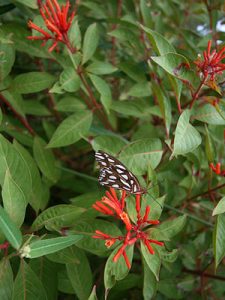
The orange-red tubular flowers of the native firebush are consistently appealing to hummingbirds as it blooms throughout much of the year. This semi-woody shrub also attracts songbirds to its black berries, and certain species of butterflies frequent its flowers. Firebush thrives in hardiness zones 9 through 11 and grows quickly, reaching a height of 6 to 12 feet and spread of 5 to 8 feet. It will produce more flowers if allowed to grow in sunny conditions, although it can survive in shade. This plant is known for being tolerant of both heat and drought. It can also grow in a range of soil conditions.
Coral Honeysuckle (Lonicera sempervirens)
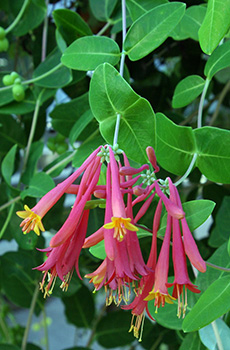
Coral honeysuckle is a native vine with bright red, trumpet-shaped flowers and perfect for a trellis or fence. Not only do hummingbirds and butterflies flock to the blooms, but the small berries draw in songbirds . The flowers appear in spring through summer against dark green leaves. Coral honeysuckle has a large range and thrives in hardiness zones 4 to 10. It’s evergreen in Central and South Florida, but further north it might lose its leaves in winter, and even die back during a freeze. It can grow up to 15 feet in length and works as a groundcover or climbing vine. This native is low maintenance, drought tolerant, and can survive in most soil types.
Scarlet Hibiscus (Hibiscus coccineus)

Scarlet hibiscus, also called marsh hibiscus, adds an exuberant flair to the landscape with its large, deep-red flowers that appear mid to late summer. It attracts both hummingbirds and butterflies with with flowers measuring 5 to 6 inches wide. This herbaceous perennial is hardy in zones 8 to 10 with a preference for full sun or partial shade and thrives in moist soil. It can grow quite large given the right conditions, reaching 4 to 8 feet tall and 3 to 4 feet wide. Scarlet hibiscus can be used as a specimen plant in the landscape and works well around ponds and streams.
Cardinal Flower (Lobelia cardinalis)
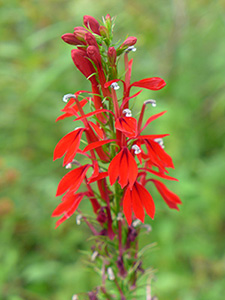
Cardinal flower is an aquatic perennial native to the wetlands of Florida. It can be found in bogs, ditches, woodland edges, swamps and stream banks across the state, making it an excellent addition to a rain garden. It serves as a hummingbird attractant with its tubular red flowers. In fact, the plant is entirely dependent upon hummingbirds for pollination because other pollinators have trouble accessing the internal structure of the flowers. This deciduous shrub is hardy in zones 3 to 9 and grows well in full sun or partial shade.
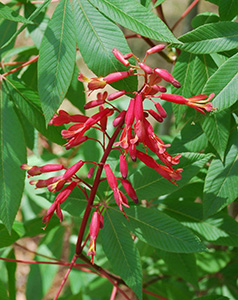
Red buckeye produces clusters of tubular red or burgundy blooms in the spring, aptly shaped for hummingbirds. It makes a great wildlife-friendly plant; bees and butterflies visit the flowers, and birds and mammals feed on its fruit and seeds. This small deciduous tree is native to the southeastern United States and is hardy in zones 6a through 9a. It reaches 15 to 20 feet tall in the home landscape and can also be maintained as a shrub . It works well in woodland areas or along ponds and streams. Make sure to water this plant until established and during dry spells. Be mindful that all parts of the plant are poisonous to humans and toxic to pets if ingested.
Coral Bean (Erythrina herbacea)

Coral bean flowers develop on long stalks in the early spring and sometimes fall. The vibrant red blooms are thin and tubular, attracting both hummingbirds and butterflies. This plant is recognizable for its near-black seed pods that open to reveal shiny, scarlet seeds. These seeds are poisonous, so keep them away from kids and pets. Coral bean does well in hardiness zones 8 to 11 in fertile, well-drained, sandy soil. The plant will grow as a large deciduous shrub or small tree in South Florida. In North and Central Florida, it can serve as a large landscape plant, reaching upwards of 6 feet.
Scarlet Sage (Salvia coccinea)
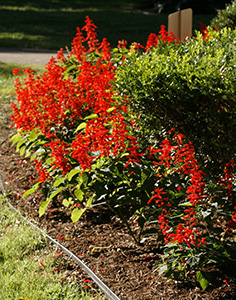
Scarlet sage is a native salvia species with tubular flowers in shades of scarlet, pink or white. The blooms appear in spring, summer and fall, attracting both butterflies and hummingbirds. The herbaceous plant grows in hardiness zones 7 through 11 with a preference for full sun conditions, as flowering is reduced with partial shade. It has a moderate drought tolerance and can survive in a variety of different soil types. Reaching a height of 2 to 4 feet, it can be used as a tall groundcover or border. It performs well in the heat, supporting hummingbirds even through the summer months.
Whether you’re just looking to catch a glimpse of these tiny, magnificent creatures, or wish to provide habit to hummingbirds, these plants will do the trick. Check your local native plant nursery for these and other hummingbird-friendly plants. For more information on gardening for hummingbirds, contact your county Extension office.
Also on Gardening Solutions
- Bottlebrush
- Cigar Flower
- Columbine
- Firecracker Plant
- Firespike
- Gardening for Birds
- Horsemint
- Hummingbird Feeders
- Providing Water to Wildlife
- Shrimp Plant
- Soap Aloe
- Starburst Clerodendrum
- Turk’s Cap Mallow
- Wildflowers for all Seasons
